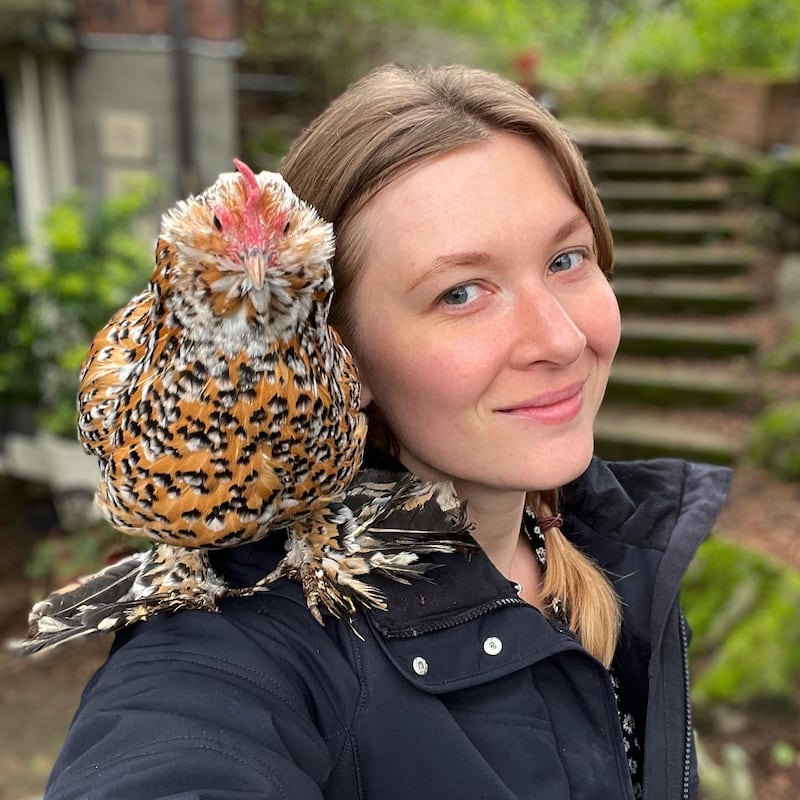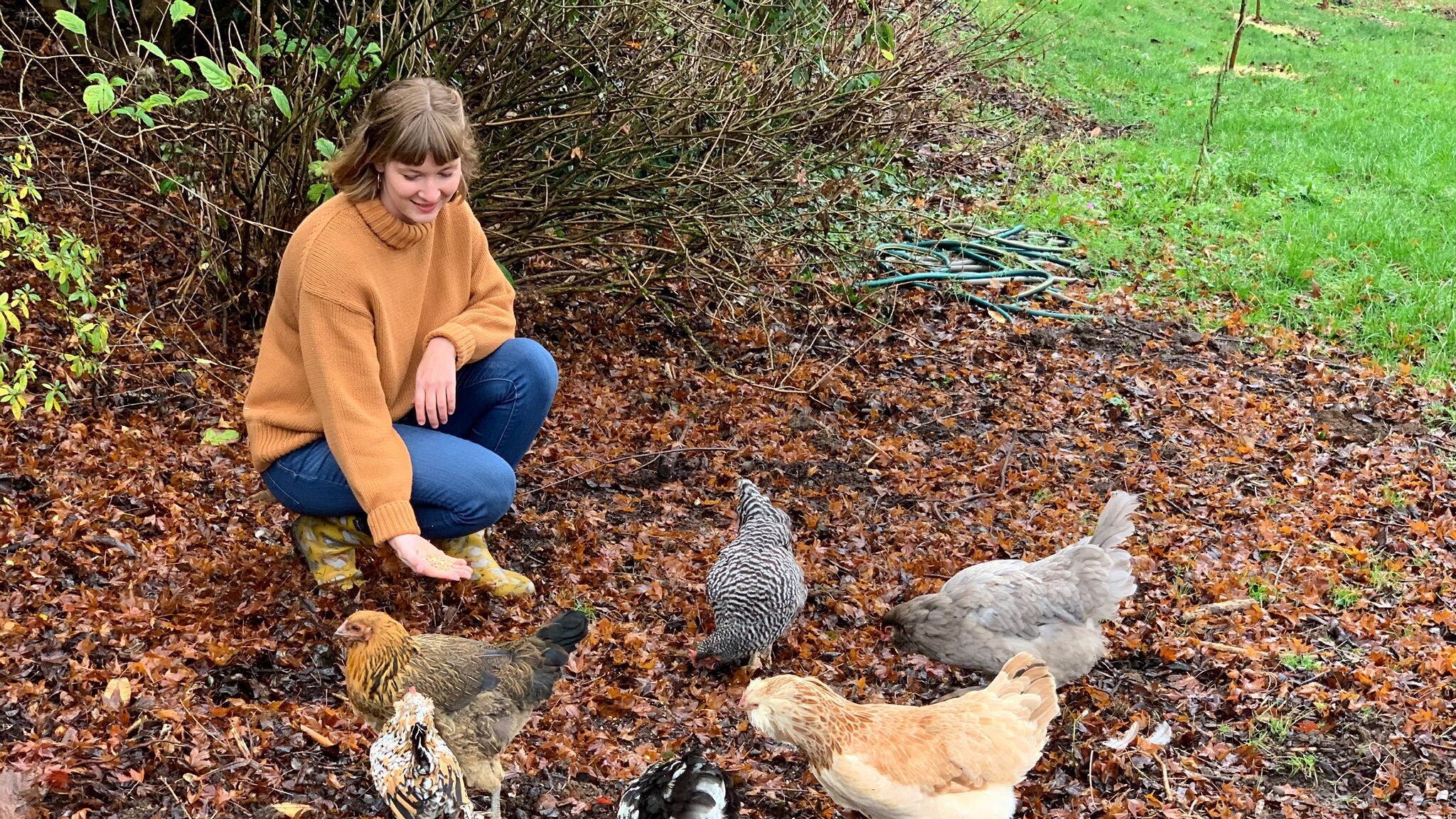One thing local writer Tove Danovich’s new book quietly reveals: She and her chickens live outside of Portland proper, as most residents within city limits can’t keep a flock of more than four. Under the Henfluence: Inside the World of Backyard Chickens and the People Who Love Them (Agate Publishing, 232 pages, $27) has more clucking characters than that, including Peggy, Joan, and Betty; Olivia, Harriet, and Scully; Emmylou and Loretta; and Thelma and Louise.
“Where we are, we can technically have up to 50 chickens, which is wild,” Danovich says. “We do not have 50 chickens. We have eight right now.”
Danovich’s relationship with her myriad (and multicolored) breeds is the foundation of a lovingly researched and reported book about the lives of chickens, organized loosely into sections about chickens at home, chickens at work, and chickens in the wild. Anyone who already thinks about eating ethically, or has read books like Fast Food Nation or The Omnivore’s Dilemma, already knows how badly these birds have it in their role in American agriculture—be they egg-laying hens, so-called broilers, or roosters that are euthanized—including the fact that they are not protected by federal humane slaughter laws.
Under the Henfluence animates these realities by introducing us to chickens and chicken people, both individually and collectively, including mail-order hatchery chicks, therapy chickens, 4-H club chickens, feral chickens and rescued roosters. Ultimately, as Danovich says, the book asks the question, “Who are chickens without us, and sometimes despite us?”
WW: What made you want to get your first chicks?
Tove Danovich: As a food writer, I initially got them thinking that they would be food-producing animals that I take care of in exchange [for eggs] and not much more than that. But, very quickly, I just got so interested in them and their little lives and why they were doing all the things that they were doing.
In the book, you talk about how you originally imagined what I think a lot of us imagine: an idyllic scene of chickens laying eggs, but also the possibility of a fresh chicken dinner rather than keeping them to the end of their natural lives—although you said you’d probably give them to friends instead.
Yeah, that was definitely what I thought going into it. I knew myself enough to know [that once] I’ve raised these animals, and gotten to know them, I would probably rather not eat them myself. I have a lot of problems with industrial chicken farming, but in theory, the idea of raising an animal, giving them a good life where they live outside and get to express all of their natural behaviors, and then using them for food is not as ethically fraught to me.
Probably within about six months of having them, I realized that had changed completely, which is not uncommon among chicken-keepers at all. So I haven’t eaten any chicken in close to five years now. And I don’t eat any poultry either because it was like, why not? Easy to avoid turkey or duck.
So, from the book we know you’ve had chickens named after Mad Men characters, fictional detectives and country singers, as well as Thelma & Louise. Has there been a new round of naming inspiration?
Well, I have only added two more. Rose and Blanche—two of The Golden Girls—and they actually came with those names. They are Cochin bantam chickens in colors that are kind of unusual—like, “ooh, fancy chickens”—so they got to keep the names that they came with.
Were they rescues?
No, I got them from a Facebook group. Someone was rehoming their chickens. Trying to downsize their flock.
But, as you write about in the book, it is possible to “adopt, don’t shop” for chickens.
Yeah, exactly. What the industry considers “spent hens” are around 18 to 24 months old. They go through their first molts. It’s not that they are too old to lay eggs—it’s just that molting takes a long time, and farmers don’t want to feed these chickens while they’re not laying. And they’re not worth anything for food, so they don’t go into the food supply. So we kill them. It’s just a really sad waste of life.
But the U.K. popularized this thing where people go to farms and rescue as many hens as they can find homes for, and give them lives where they get to be chickens for the first time. I had two of them, Thelma and Louise. And they laid so many eggs, and they were just so sweet and fun.
So tell me how you’ve come to have a few chickens named after you.
It’s such a delight. One [belongs] to a writer who actually reviewed my book and wanted to rescue chickens of her own after reading it. So one of her rescue chickens she named Tove in my honor. And then Tanya Bailey, whose therapy chickens appear in my book, she has two new silkies that will soon be in training for the program, and one of them is named Tove. So hopefully Tove makes it. And then this woman was at my reading in Minneapolis and we were chatting and she mentioned that she had a new chicken that she named Tove as well. It’s an absolute delight and honor that was not on my list of things that might happen when I wrote this book.
Finally, how do you like your eggs?
I like them in all kinds of ways. This time of year, we just got our first heat wave, and we currently have way too many eggs, so I will probably be making some of those into ice creams and sorbets. Ice cream making was my lockdown cooking thing, and it has continued because it’s delicious and a fun project.


